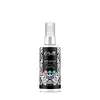What's inside
What's inside
 Key Ingredients
Key Ingredients

 Benefits
Benefits

 Concerns
Concerns

 Ingredients Side-by-side
Ingredients Side-by-side

Water
Skin ConditioningAlcohol Denat.
AntimicrobialButylene Glycol
HumectantGlycerin
HumectantIsopropyl Palmitate
EmollientCetearyl Isononanoate
EmollientDiisopropyl Adipate
EmollientPropylheptyl Caprylate
EmollientCetearyl Alcohol
EmollientDistarch Phosphate
AbsorbentSodium Hyaluronate
HumectantTocopherol
AntioxidantSodium Ascorbyl Phosphate
AntioxidantIsobutylamido Thiazolyl Resorcinol
BleachingGlycyrrhiza Inflata Root Extract
Skin ConditioningGlucosylrutin
AntioxidantIsoquercitrin
AntioxidantGlycine Soja Oil
EmollientGlyceryl Stearate
EmollientHydroxypropyl Starch Phosphate
Dimethicone
EmollientDehydroxanthan Gum
Emulsion StabilisingSodium Stearoyl Glutamate
CleansingXanthan Gum
EmulsifyingGellan Gum
Sodium Chloride
MaskingPhenoxyethanol
PreservativeEthylhexylglycerin
Skin ConditioningTrisodium EDTA
Citric Acid
BufferingParfum
MaskingWater, Alcohol Denat., Butylene Glycol, Glycerin, Isopropyl Palmitate, Cetearyl Isononanoate, Diisopropyl Adipate, Propylheptyl Caprylate, Cetearyl Alcohol, Distarch Phosphate, Sodium Hyaluronate, Tocopherol, Sodium Ascorbyl Phosphate, Isobutylamido Thiazolyl Resorcinol, Glycyrrhiza Inflata Root Extract, Glucosylrutin, Isoquercitrin, Glycine Soja Oil, Glyceryl Stearate, Hydroxypropyl Starch Phosphate, Dimethicone, Dehydroxanthan Gum, Sodium Stearoyl Glutamate, Xanthan Gum, Gellan Gum, Sodium Chloride, Phenoxyethanol, Ethylhexylglycerin, Trisodium EDTA, Citric Acid, Parfum
Water
Skin ConditioningSqualane
EmollientSd Alcohol 40-B
AstringentAlpha-Arbutin
AntioxidantPropylene Glycol
HumectantKojic Acid
AntioxidantGlutathione
Azelaic Acid
BufferingEthoxydiglycol
HumectantGlycerin
HumectantCetyl Alcohol
EmollientDimethyl Isosorbide
SolventNiacinamide
SmoothingResveratrol
AntioxidantButylene Glycol
HumectantDipotassium Glycyrrhizate
HumectantGlyceryl Stearate
EmollientCaprylic/Capric Triglyceride
MaskingHydroxypinacolone Retinoate
Skin ConditioningAmmonium Acryloyldimethyltaurate/Vp Copolymer
Phenoxyethanol
PreservativeEthylhexylglycerin
Skin ConditioningWater, Squalane, Sd Alcohol 40-B, Alpha-Arbutin, Propylene Glycol, Kojic Acid, Glutathione, Azelaic Acid, Ethoxydiglycol, Glycerin, Cetyl Alcohol, Dimethyl Isosorbide, Niacinamide, Resveratrol, Butylene Glycol, Dipotassium Glycyrrhizate, Glyceryl Stearate, Caprylic/Capric Triglyceride, Hydroxypinacolone Retinoate, Ammonium Acryloyldimethyltaurate/Vp Copolymer, Phenoxyethanol, Ethylhexylglycerin
 Reviews
Reviews

Ingredients Explained
These ingredients are found in both products.
Ingredients higher up in an ingredient list are typically present in a larger amount.
Butylene Glycol (or BG) is used within cosmetic products for a few different reasons:
Overall, Butylene Glycol is a safe and well-rounded ingredient that works well with other ingredients.
Though this ingredient works well with most skin types, some people with sensitive skin may experience a reaction such as allergic rashes, closed comedones, or itchiness.
Learn more about Butylene GlycolEthylhexylglycerin (we can't pronounce this either) is commonly used as a preservative and skin softener. It is derived from glyceryl.
You might see Ethylhexylglycerin often paired with other preservatives such as phenoxyethanol. Ethylhexylglycerin has been found to increase the effectiveness of these other preservatives.
Glycerin is already naturally found in your skin. It helps moisturize and protect your skin.
A study from 2016 found glycerin to be more effective as a humectant than AHAs and hyaluronic acid.
As a humectant, it helps the skin stay hydrated by pulling moisture to your skin. The low molecular weight of glycerin allows it to pull moisture into the deeper layers of your skin.
Hydrated skin improves your skin barrier; Your skin barrier helps protect against irritants and bacteria.
Glycerin has also been found to have antimicrobial and antiviral properties. Due to these properties, glycerin is often used in wound and burn treatments.
In cosmetics, glycerin is usually derived from plants such as soybean or palm. However, it can also be sourced from animals, such as tallow or animal fat.
This ingredient is organic, colorless, odorless, and non-toxic.
Glycerin is the name for this ingredient in American English. British English uses Glycerol/Glycerine.
Learn more about GlycerinGlyceryl Stearate is a mix of glycerin and stearic acid.
It is used to stabilize the mixing of water and oil ingredients. By preventing these ingredients from separating, it can help elongate shelf life. It can also help thicken the product's texture.
As an emollient, it helps soften skin and supports barrier-replenishing ingredients.
In cosmetics, Glyceryl Stearate is often made from vegetable oils or synthetically produced.
This ingredient may not be fungal-acne safe
Fun fact: The human body also creates Glyceryl Stearate naturally.
Learn more about Glyceryl StearatePhenoxyethanol is a preservative that has germicide, antimicrobial, and aromatic properties. Studies show that phenoxyethanol can prevent microbial growth. By itself, it has a scent that is similar to that of a rose.
It's often used in formulations along with Caprylyl Glycol to preserve the shelf life of products.
Water. It's the most common cosmetic ingredient of all. You'll usually see it at the top of ingredient lists, meaning that it makes up the largest part of the product.
So why is it so popular? Water most often acts as a solvent - this means that it helps dissolve other ingredients into the formulation.
You'll also recognize water as that liquid we all need to stay alive. If you see this, drink a glass of water. Stay hydrated!
Learn more about Water